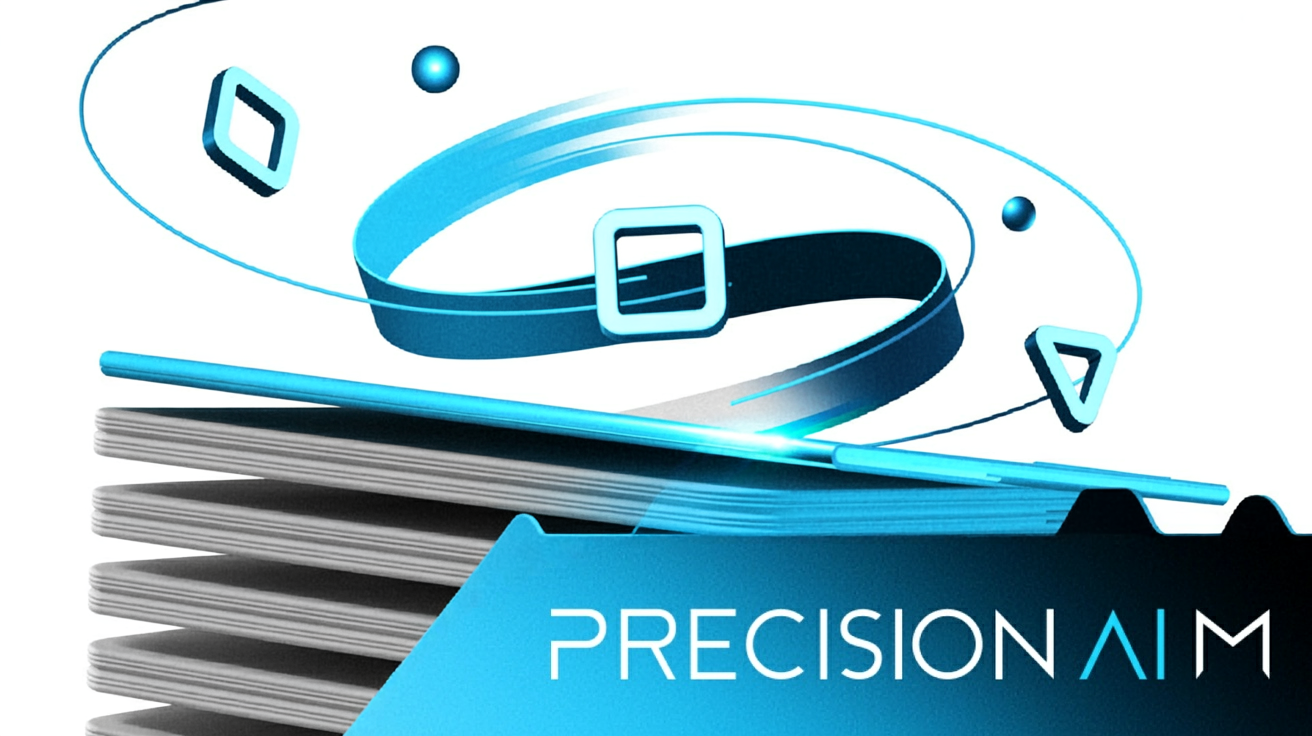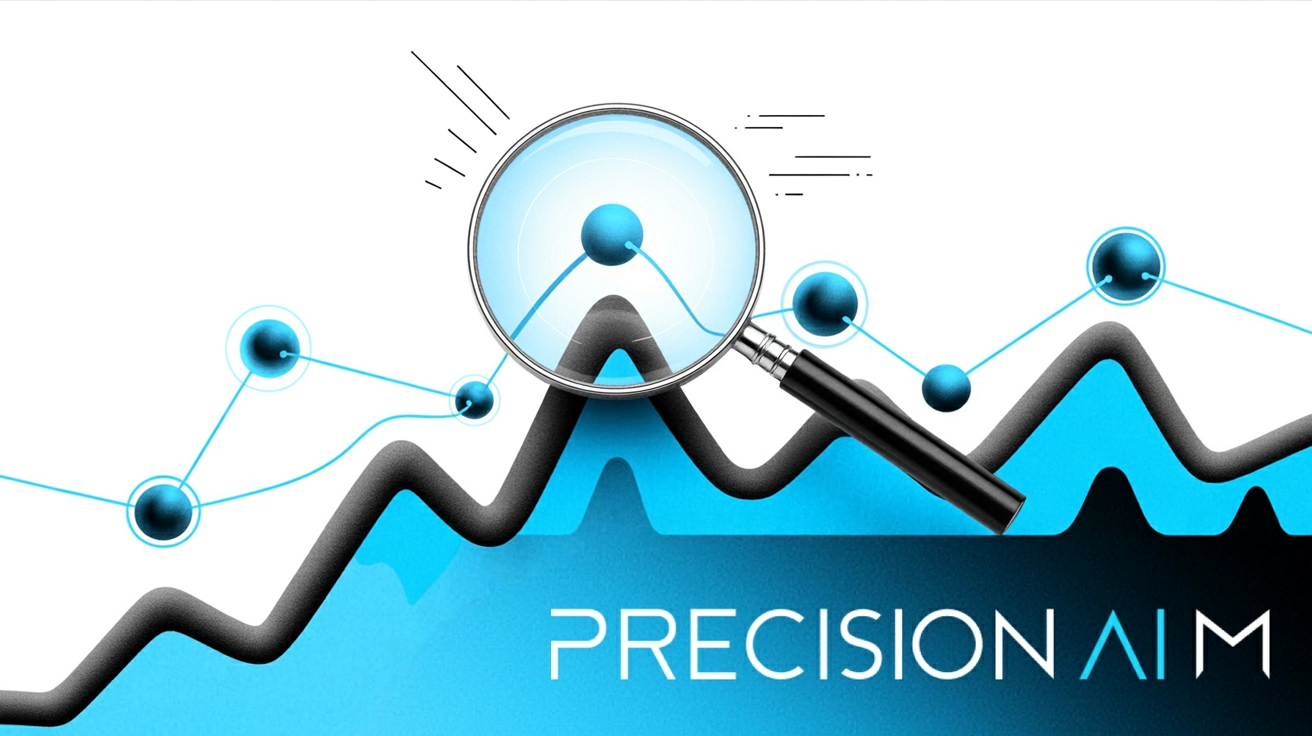Staring at a blank page can be frustrating, whether you’re a student, marketer, or writer on a deadline. I’ve seen how outlining by hand eats up time and drains energy, especially when juggling multiple projects or facing last-minute changes.
That’s where digital outline generators step in. These tools instantly turn your topic into a structured framework, tailored for essays, blogs, reports, or marketing content—no more wrestling with structure from scratch.
In this article, I’ll break down what outline generators actually do, how they differ from manual outlining, and the real advantages they offer for writers, teams, and students. You’ll see how AI-powered features, collaboration tools, and export options streamline planning and boost consistency.
I’ll also walk you through practical steps for using an outline generator effectively, highlight common limitations, and share best practices for getting the most value. By the end, you’ll know exactly how these tools fit into modern content workflows and whether they’re right for your next project.
What is an Outline Generator?
Definition of a Digital Outline Generator
A digital outline generator is a piece of software that takes your topic and gives you a structured writing framework in seconds. Imagine you're faced with a blog post, essay, or report—just enter your title or prompt, and you get a logical list of sections and main points, ready for you to develop further.
The really clever bit is found in AI-powered outline generators. Unlike static templates, they tailor the structure to your needs—shifting from a technical guide to an argumentative essay with ease. They can even personalise the organisation, suggesting subpoints specific to your prompt. It's like having a digital writing coach who never gets tired.

Scope: What Outline Generators Are (and Aren’t)
Here’s where people sometimes get mixed up. Outline generators organise the structure of written documents—they don’t do visuals, workflow, or project management. Their job is straightforward: arrange your content for formats like blog posts, essays, articles, reports, and documentation.
Let’s draw some quick lines:
- Manual Outlining
Building every section by hand, with no automation. - Mind Mapping
Visual brainstorms—no logical or hierarchical sequence. - Project Management Tools
Meant for tracking tasks, not shaping your document.
So, if you’re a student needing a quick essay plan or a marketer mapping out content for clients, outline generators handle the structure. You get a framework fast, minus the usual struggle.
Why Outline Generators Exist
Blank pages are intimidating. Plotting an outline by hand is tedious. That’s really why outline generators exist—so you never have to wrestle with structure from scratch. They make the start of every writing project just that bit smoother.
- Time Savings
Outlines in minutes—skip the hours of planning. - Workflow Improvements
Fits teams or solo writers, scales with your needs. - Collaboration
Easily share outlines for review or group editing. - Quality and Consistency
Templates and AI help keep every document on standard.
For students, agencies, and anyone juggling multiple writing projects, digital outline generators are the shortcut to clear, consistent, and efficient content.
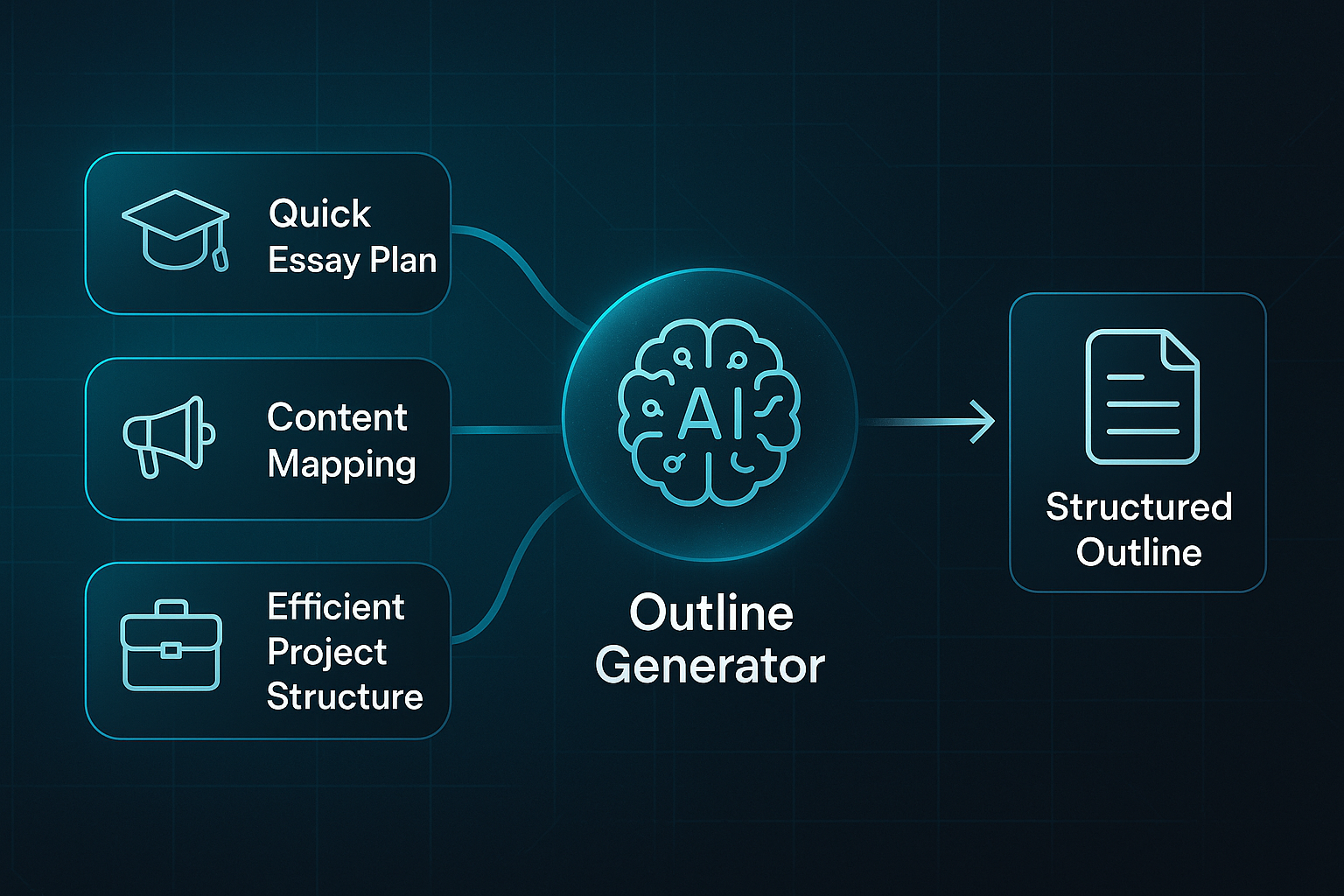
Manual outlining vs. digital outline generator: Key differences
Manual outlining process
Manual outlining always starts with brainstorming—scratching down ideas and shaping a basic framework, either on paper or your computer.
You map out headings and subheadings, adjusting as you go to match audience needs or stick with academic guidelines.
This approach hands you total creative control and lets you create custom—or even unusual—structures.
But here’s the downside: it’s slow and mentally draining, especially if you’re working on lots of documents or dealing with constant revision requests.
Ever spent hours reordering essay sections after feedback? It’s exhausting.
Digital outline generator process
Digital outline generators change the pace completely. You type in your topic, pick a content type—like a blog or report—and almost instantly receive a structured outline.
These tools rely on AI, smart templates, and data analysis to produce outlines that nail best practice and guidelines.
They also offer collaborative perks—cloud editing, instant sharing—making teamwork seamless and remote updates a breeze.
A marketer can spin up an SEO-tuned outline in seconds and share it with colleagues before the kettle boils.
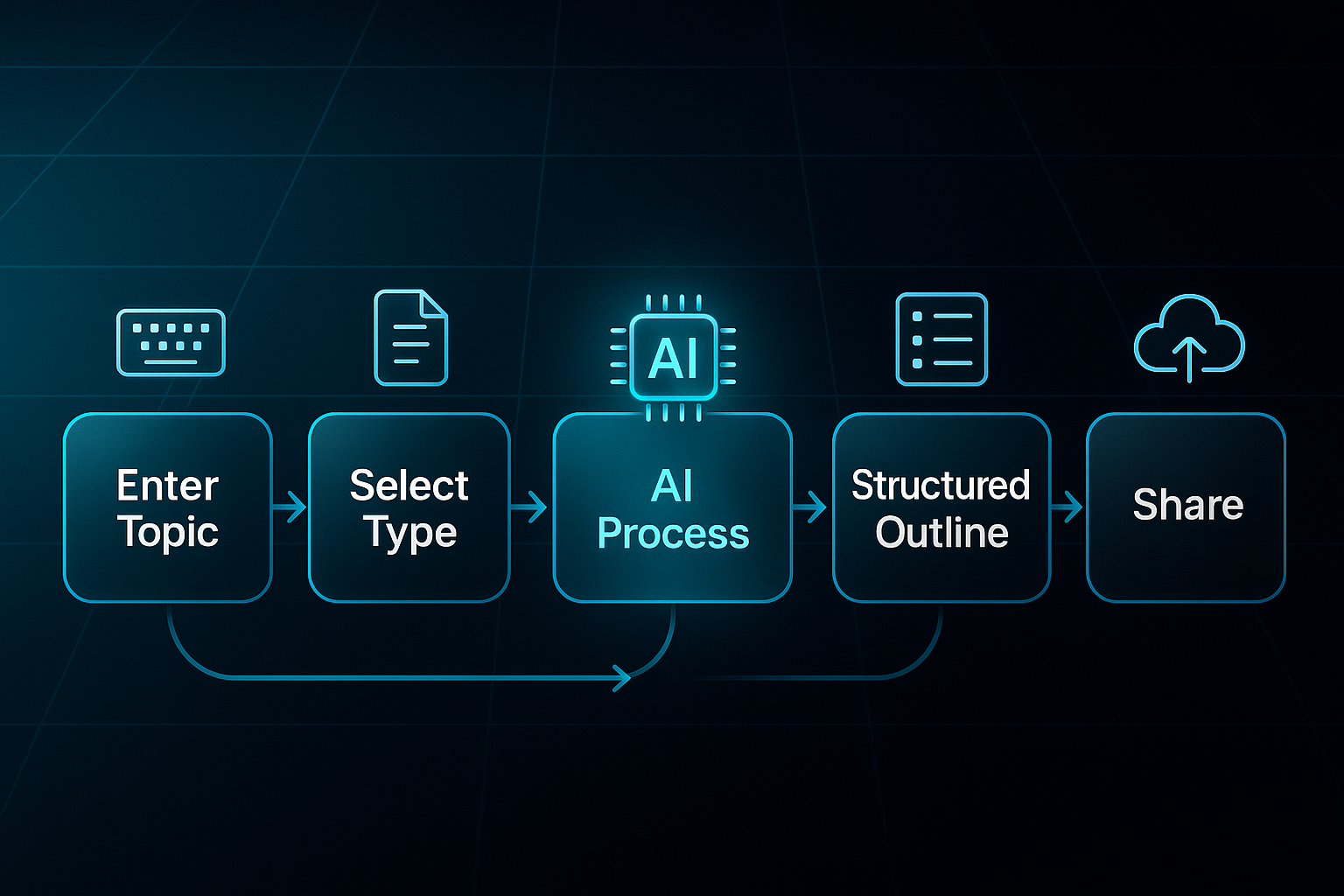
Advantages of digital over manual
Digital outline generators are all about speed, uniformity, and scaling—helpful for solo writers, and even more so for teams.
They embed keyword optimisation and flow recommendations automatically, baking best practice into every outline.
Uniform frameworks and cloud sharing let teams ditch clunky email chains.
Manual outlining still has its place for rare or highly specialised formats. But for everyday writing, digital tools offer a fast track to quality and efficiency.
Repetitive tasks that used to take hours, such as structuring multiple pieces of content for a campaign, can now be accomplished in minutes using AI-powered writing assistants.
How do outline generators work?
Core user flow
Let’s dig into how these tools really operate. Outline generators usually start by asking for a topic, prompt, or a simple keyword.
Next, you pick a few details: content type (blog, essay, or report), tone, audience, and outline depth. The tool then shapes the results around your project.
Imagine a marketer tackling a “Product Launch for Eco-Friendly Home Appliances” blog post. They type in their topic, pick “informative” tone, and set the audience as “consumer”. Instantly, section headings and subpoints appear, matched to those choices.
When you submit these details, you see a custom outline straight away. For a history student with the “Industrial Revolution”, you might receive sections like “Introduction”, “Major Social Changes”, and “Conclusion”. Suddenly, loose ideas get structured into a plan.
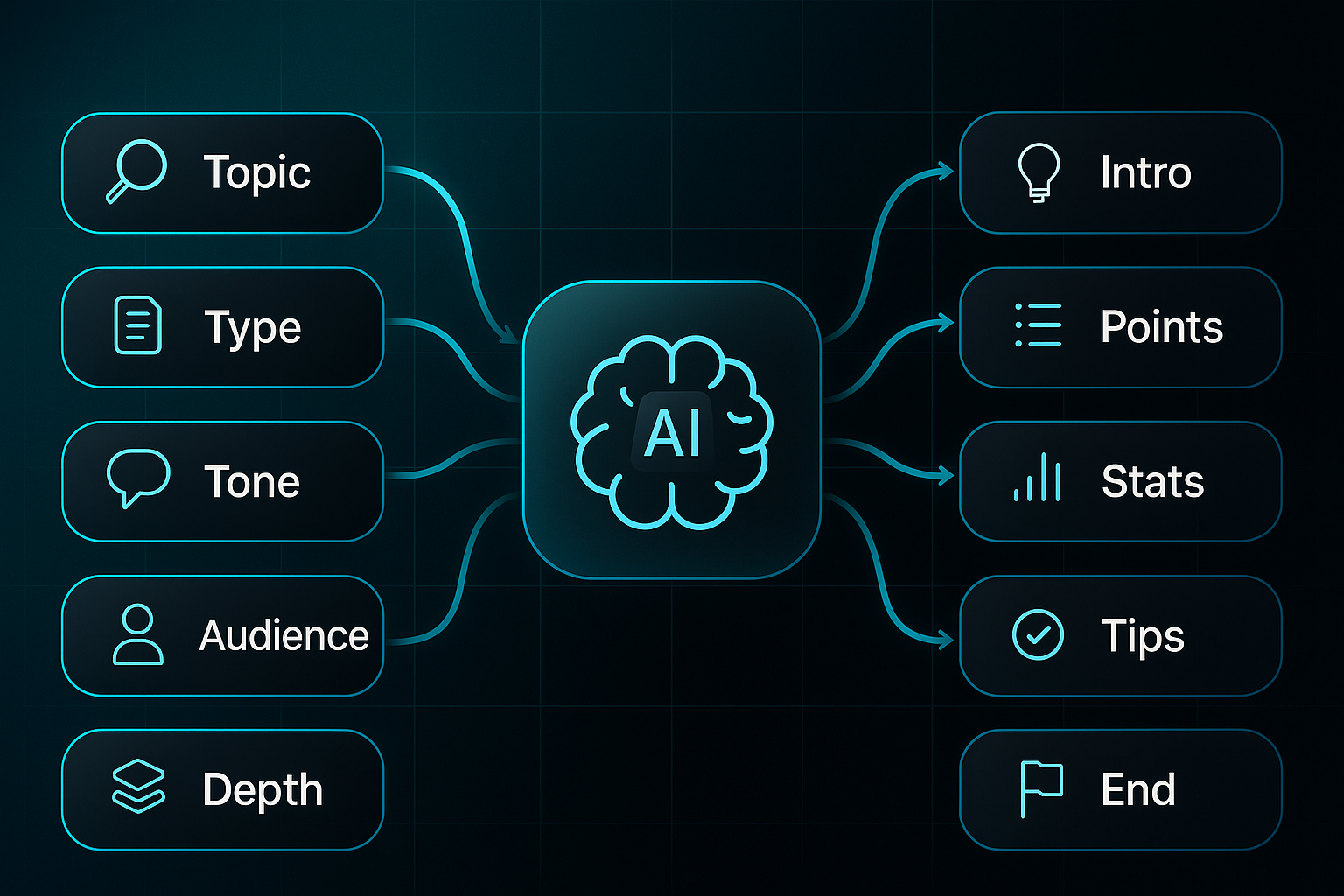
Automation and AI features
Here’s where the magic kicks in. Many generators offer libraries of standard templates, but the advanced ones harness AI and natural language processing to tailor outlines for your topic.
Pop in “2024 Digital Marketing Trends”, and out come sections like “AI in Search Marketing” or “Privacy Regulations Update”, using real-world search trends.
Customisation and editing capabilities
Flexibility is key. You can drag headings, rename them, or drop in extra notes as your project evolves. When it’s a team effort, live collaboration brings shared editing and instant comments—perfect for group projects.
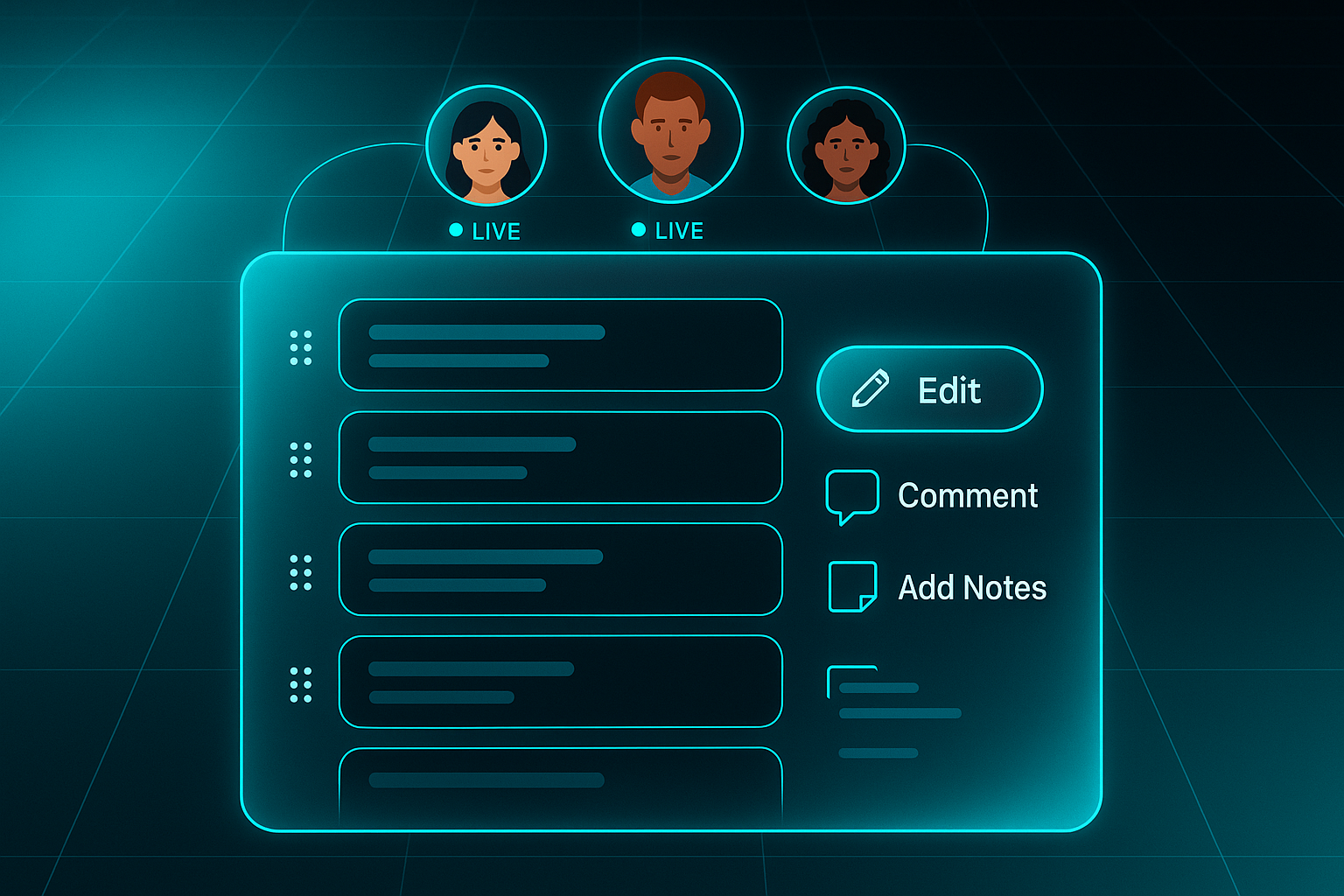
Export and integration
Once you’re happy with your outline, export it to Word, Google Docs, PDF—or share it via a direct link. Some platforms even sync with CMS or project software, so your workflow never misses a beat.
It’s all about turning plans into action—quickly.
Benefits of using an outline generator for writers, students, and marketers
Advantages for writers and authors
Writers have the most to gain in terms of speed and workflow. With an outline generator, a blog post outline appears in under five minutes—long gone are the days of slogging through structure for an hour or more.
If you're an author, these tools help you whip up tables of contents and chapter frameworks fast. That early planning makes your story or argument more consistent, and it means you’re less likely to miss important themes.
The real win? You can create and organise multiple outlines per hour, freeing up time for the actual writing.
Advantages for marketers and agencies
For marketers and agencies, the difference is night and day. Teams can generate SEO-focused outlines for heaps of projects in less than thirty minutes—no more long review cycles or endless internal emails.
Built-in keyword optimisation and competitive analysis features make brainstorming easier and content ideas stronger. Plus, with collaborative features, everyone gets instant assignments and feedback, streamlining even the busiest schedules.
The outcome is simple: improved content structure adds up to more organic traffic and smoother project delivery.
Advantages for students and academics
Students and academics get to leap over that dreaded blank page. Instead of hours lost to planning, they can turn confusing prompts into actionable outlines—essay or research plans take as little as twenty minutes.
Live collaboration and easy sharing mean peer reviews or group project edits happen quickly. The upshot? Less anxiety, better teamwork, and stronger, clearer assignments.
A study of fifth-grade students found that writing quality improved when using an online tool, with the average score increasing from 10.5 (with paper and pencil) to 12.5 (with the online tool) out of a possible 16.
General benefits for all users
Here’s what stands out for everyone. Outline generators break big projects into sections, banish writer’s block, and minimise fatigue. Ready-made templates and automated best practices mean you get top-notch, consistent quality.
It doesn’t matter if you’re working solo or part of a team: clearer frameworks, faster starts, and more confident results follow—no matter what you’re writing.
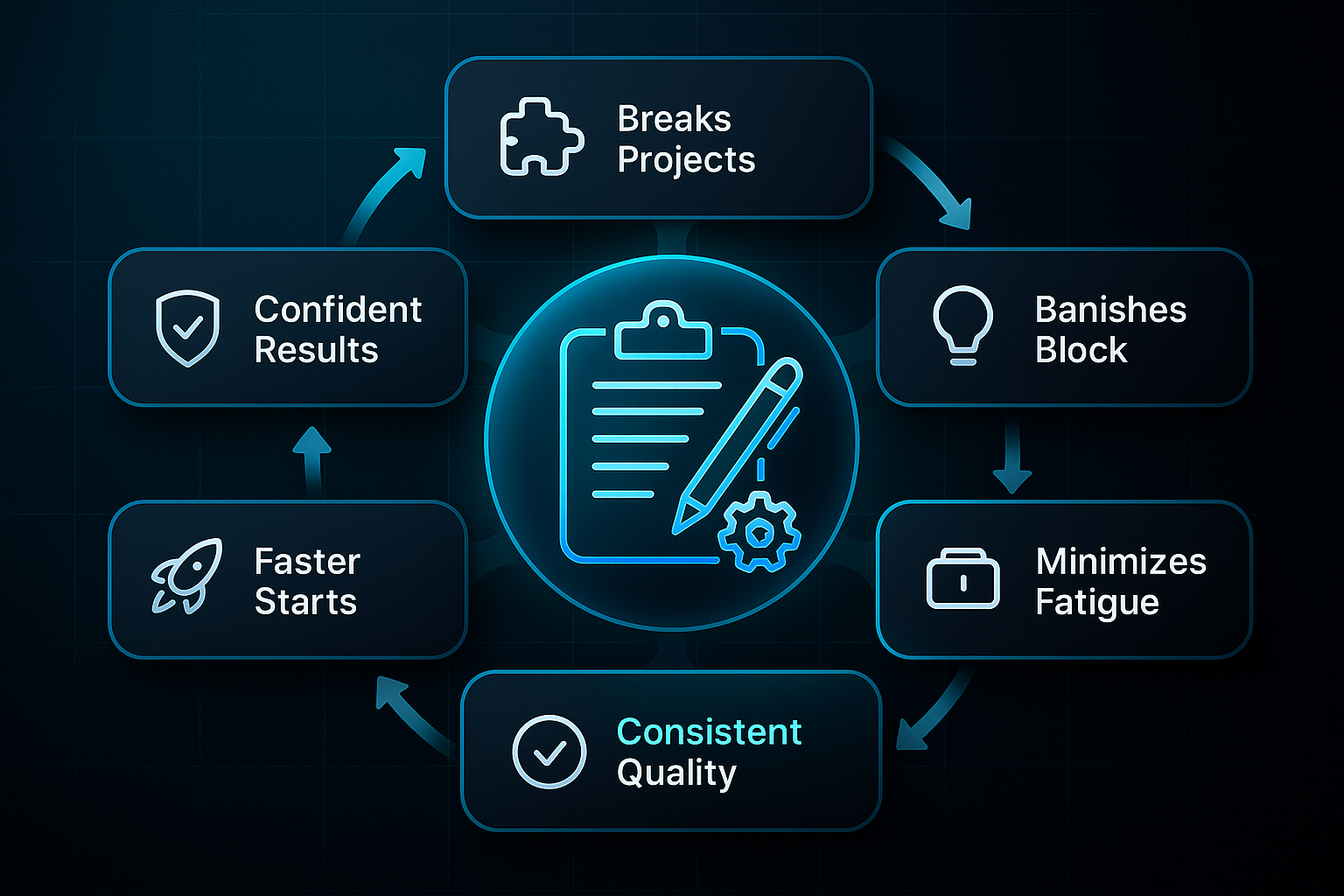
Types of content you can create with an outline generator
Supported content types
Curious about just how much an outline generator can help? These tools are flexible enough for students, writers, and marketers, organising a huge range of content types.
Blog posts, listicles, and pillar pages
Creating online content is easier when posts are automatically split into introductions, key points, and calls to action. Marketers quickly map out campaigns and SEO-friendly pillar pages—no fuss.
Academic essays and research papers
For students, outline generators take away the stress. They structure essays or research papers with thesis statements, arguments, supporting evidence, and proper citations, all lined up in correct order.
Business and technical reports
Professionals get reliable frameworks for every report or proposal. Executive summaries, objectives, and recommendations are automatically included, making thorough, polished papers simple to produce.
Marketing content: landing pages, newsletters, and briefs
Marketers also lay out landing pages, newsletters and briefs in less time, with each section—including keyword targeting—fitting logically and clearly.
Creative writing: book outlines and chapters
Even authors benefit: outlining chapters, plots, and characters becomes manageable, turning big projects into clear, step-by-step plans.
No matter who you are, outline generators provide blueprints that remove blank page anxiety and help you shape your best work, faster.
Typical features and advanced options in leading outline generators
Core features overview
Most outline generators kick off with a simple prompt or topic. Instantly, the tool scans for keywords and delivers a tailored outline—no manual slog necessary.
You pick from templates for blogs, essays, or reports, then adapt the structure to your needs. Real-time editing means you can shuffle, rename, or expand sections as your ideas evolve.
Whether you’re working alone or collaborating, everything stays flexible and quick to update.
AI and automation capabilities
Here’s the clever part—AI drives most modern tools. It builds out sections and generates headlines, saving you hours.
AI recommendations fine-tune structure for your audience or SEO targets. Need inspiration? Expansion prompts help add detail and break through writer’s block.
Collaboration and workflow integration
If teamwork’s involved, multi-user editing lets everyone comment and tweak in real time. Cloud-based platforms keep changes central and accessible.
Ready to draft? Just export your outline to Google Docs, Word, or your preferred CMS—handy for agencies and teams needing a smooth workflow.
Recent innovations and advanced options
Newer generators now integrate live SEO and research checks, allow template and style guide uploads, and offer dashboards to track outline progress.
Some agencies report spending 60% less time on planning, while students benefit from custom outlines built off assignment briefs. Marketers can keep campaigns consistent by applying style guides.
In one case study, digital agency The Crew achieved a 60% faster content production cycle by adopting collaborative AI tools.
SEOSwarm by Precision AI Marketing shows off advanced AI for full content strategy and direct publishing at scale.
Feature summary
- AI/Automation
Instantly generates outlines from prompts—cuts planning time for writers, students, and marketers. - Templates
Pre-set structures for blogs, essays, and reports—a cure for blank-page nerves. - Collaboration
Multi-user editing and live comments mean fast teamwork. - Integration
Export to writing apps or CMS for a seamless move to drafting. - SEO/Research
Built-in suggestions sharpen accuracy and relevance. - Personalisation
Upload style guides to keep branding or academic standards on track. - Analytics
Track outline process to spot gaps and refine teamwork.
So, whatever your project, these features make planning faster and collaboration smoother.

AI-Powered
SEO Content Strategy
See the AI platform that's replacing entire content teams
(with better results).

How to use an outline generator effectively: A step-by-step guide
Turning a blank page into a well-structured draft isn’t as hard as it sounds—especially with outline generators. Let’s walk through five simple steps for quick, high-quality outlines, whether you’re tackling an essay, blog, report, or marketing piece.
Step 1: Choose your outline generator
Start by picking a tool that suits your needs. Look for AI-powered suggestions, templates, SEO features, or easy export options. Writers, marketers, and students each benefit from different features, so match accordingly.
Step 2: Input your topic and details
Enter your main topic or prompt. Add keywords, choose your audience, and specify the tone or style. Some generators accept assignment notes or briefs for sharper, targeted results.
Step 3: Select templates and preferences
Choose a template for your project type—blog, essay, report, or something creative. Adjust outline depth and tweak section choices so the structure matches your requirements, whether simple or complex.
Step 4: Generate and refine your outline
Review the outline for logical flow and completeness. Edit headings or points to improve clarity and use expansion tools to add evidence or detail where needed.
Step 5: Export or integrate with your writing tools
When you’re happy, export the outline to Word, Google Docs, or your favourite platform. For teamwork, cloud sharing allows real-time edits, and direct publishing works well for marketing tasks.

Actionable checklist for best results by step
- Match tool to workflow
Choose a generator suited to your project and platform. - Specify input details
Input topic, keywords, audience, and any brief. - Select the best template
Confirm your template fits the content type. - Actively refine outline
Edit and clarify for quality and detail. - Export or integrate cleanly
Transfer or collaborate in real time.
Real-world applications: Who uses outline generators and how?
Individual writers and authors
Freelancers, bloggers, and book authors use outline generators to turn jumbled ideas into clear structures fast.
It’s a genuine game-changer. Planning a month of blog posts, or keeping a big project on track with character notes and plot mapping tools? That’s done in minutes.
Marketing teams and agencies
Marketers convert campaign keywords into detailed content plans—and update them quickly if priorities shift. Ever panicked over a last-minute campaign pivot? These tools relieve that stress.
Agencies love preparing targeted outlines for several clients at once. Workflow is smooth and nothing gets missed.
Students and academics
Students and academics use outline generators to break essays or theses into logical sections. Why struggle for hours when you can organise it all in under ten minutes?
A dissertation literature review outline appears almost instantly.
Agencies and enterprises
Big organisations coordinate content with collaborative templates and AI-enabled structures.
The benefits? Consistency, smooth teamwork, and rapid campaign execution—even across lots of departments.
Potential limitations and user concerns with outline generators
Creativity and originality limits
AI outline generators often deliver predictable structures, especially for broad topics, so true originality can take a back seat. Use these outlines as a launchpad—add your insights, shuffle sections, and get specific with your prompts for more creative results.
Template overuse and distortion
Relying on standard templates too often creates uniform content, which can tire both you and your audience. It can even affect SEO if similar outlines appear across many pages. Keep things lively by blending templates, changing up order, and adding your own examples.
Data privacy and topic ownership
Concerned about privacy when sharing ideas online? That’s common. Always check a tool’s privacy and deletion options. Anonymise sensitive input and limit team access to protect your intellectual property.
Suitability for complex or nuanced topics
With complicated or controversial topics, generators might overlook depth or minority perspectives. Manual review and input from expert sources, or the addition of sections on history or ethics, help create a more robust outline.
Best practices for getting the most from your outline generator
To get true value from your outline generator, think beyond basic prompts. Start with highly specific input—name your audience, tone, objectives, and even structure. The more focused you are at the start, the smarter the results.
Treat every draft as just that—a beginning, not an end. Look closely at headings and subpoints, reshuffling or expanding with your own expert insights. That’s where originality enters the picture, far beyond what AI alone can do.
Working in a team? Dive into real-time collaboration—assign key sections, leave instant comments, and work from a single master outline for rock-solid version control. Group brainstorming inside the tool helps you all sync up early, saving hassle later.
And don’t just polish—refine your process. Review analytics, tweak templates when you see what connects, and let your resources evolve. Your outlines—and your content—only get stronger over time.
How outline generators fit into a modern content strategy: SEOSwarm and beyond
Digital outline generators have quietly slipped into the heart of modern content strategies. What began as basic tools for writers now supports big-picture planning, automation, and smart integration with SEO analytics. For any organisation regularly releasing content, these generators mean teams can align, move quickly, and guarantee every draft matches wider objectives.
Role in end-to-end content workflows
Think of outline generators as the blueprint for a streamlined, SEO-driven workflow. With built-in keyword planning, strategists can set direction, writers work from clear plans, and editors check for quality. Feedback loops, together with version control, let outlines adapt based on performance. No matter the team size, everyone pulls in the same direction.
Precision AI Marketing’s SEOSwarm: A case example
Let’s bring this to life with SEOSwarm by Precision AI Marketing. Their model combines expert strategy and research from humans, then leverages AI agents for outlines, writing, and SEO tweaks. Content pushes straight to publishing, with analytics tracking results. Need updates for multi-brand or complex projects? SEOSwarm takes care of it after you provide initial input.
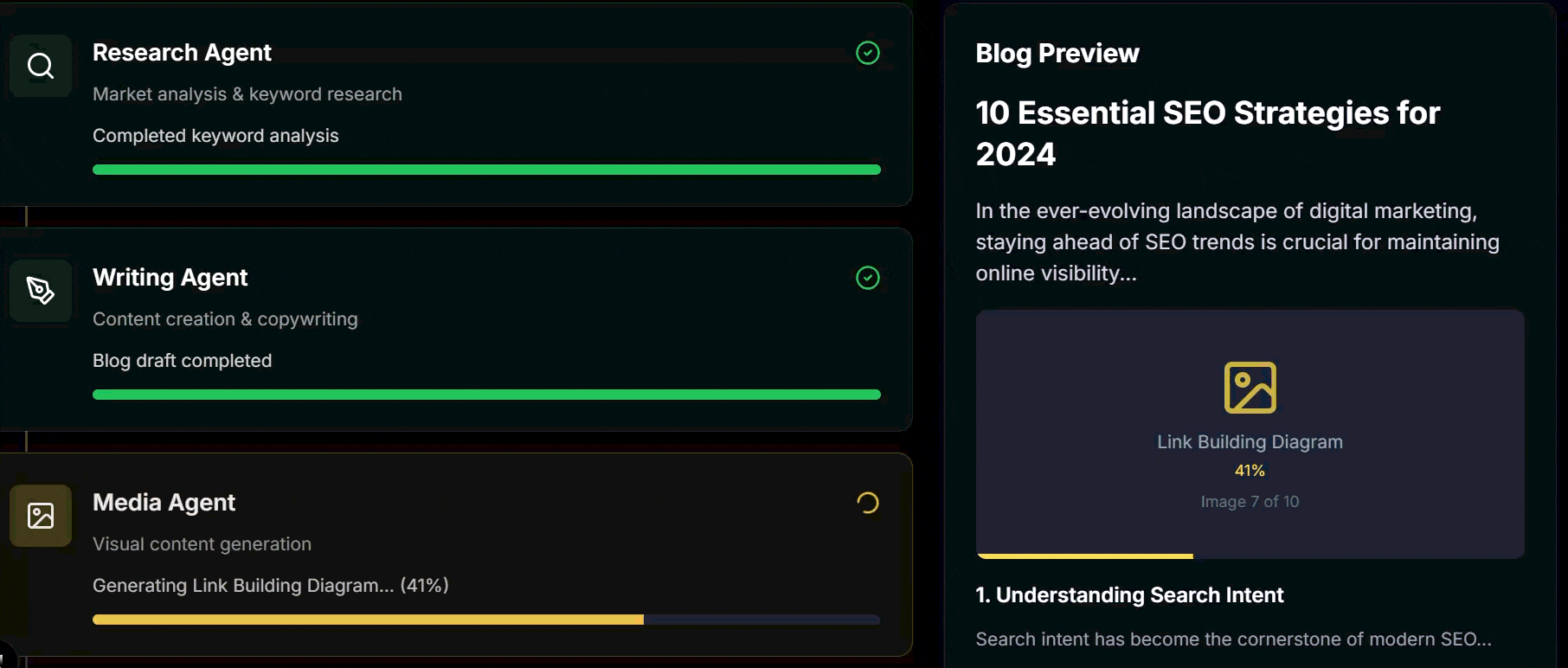
Blog-in-one-minute: Instant blog site and outline creation
If you value speed, Blog-in-one-minute from the same team builds blogs and outlines instantly with just a couple of lines of code. Content generation, SEO editing, and ongoing updates all happen automatically, working smoothly on any site.
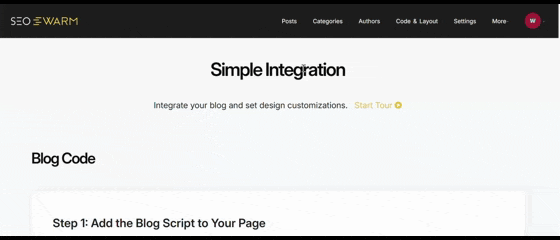
Strategic insight and value for agencies and enterprises
SEOSwarm and Blog-in-one-minute highlight a shift to scalable, SEO-driven content. Agencies and enterprises win speed, consistency, and freedom to evolve strategy across high volumes—keeping content competitive and aligned as their needs grow.
Blog-in-one-minute
Add a fully SEO-optimised blog to your website with just 2 lines of code.
Learn more
Making Outline Generators Work for You
Blank pages don’t have to be intimidating. The real advantage of outline generators is how they turn that first step—from idea to structure—into a fast, repeatable process. Whether you’re a student, marketer, or writer, you can skip the hours spent wrestling with frameworks and get straight to the work that matters.
Here’s my advice: treat your outline generator as a launchpad, not a crutch. Start with specific prompts, refine the results, and always add your own insights. For teams, lean into real-time collaboration and integration features—these are where the biggest workflow gains happen.
The smartest creators use digital tools to save time on structure, then invest that time in originality and depth. Outlines aren’t the end goal—they’re the springboard for your best work.
- Wil
